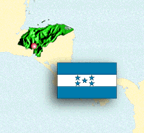The best station to look for is Radio Internacional from San Pedro Sula,
which broadcasts on the shortwave frequency of 4930 kilohertz. This is
a relay of their commercial mediumwave (AM) service in San Pedro Sula.
Programming consists of a variety of musical styles, depending on the hour,
ads, Honduran news, and everything you would expect to find on a mid-sized
commercial radio station. All programming is, of course, in Spanish.
Radio Internacional can be heard in the morning from their sign-on until
it fades out with the dawn. Sign-on is usually at 1100 UTC (0500 am
Honduran time). The station can be heard again in the evening from roughly
your local sunset until it signs-off for the night at around 0500 or 0530
UTC (1100 or 1130 p.m. Honduran time.)
Other easily heard Honduran shortwave station are La Voz Evangelica from
Tegucigalpa on 4820 kilohertz, Radio Luz y Vida from San Luis in Santa
Barbara on 3250 kiloherta, and Radio Immanuel from Puerto Lempira on
4960 kilohertz. These are all evangelical religious stations. Programming
is primarily in Spanish. The first two stations carry some prerecorded
English religious programs from the US in the late evening. Radio
Immanuel has some broadcasts in Miskito and other local languages. These
stations can all be heard roughly at the same times as Radio Internacional,
although Radio Immanuel and Radio Luz y Vida sign-off somewhat earlier.
Because good long-distance reception on lower frequencies requires
a darkness path, obviously these stations will be best heard during
the North American winter months and least well heard during the North
American summer. Likewise, the stations can be heard earlier in the evening
and later in the morning during the winter months when there is more
darkness.
This item is placed in the public domain.
This website is maintained by Don Moore,
Honduras Menu
Main Menu
What's New
Best of this Site
Radio History
Clandestine Radio
Hearing Honduras on Shortwave
By Don Moore

 Because Honduras is relatively close to North America, it is one of
the easier Latin American countries to hear. Unless you are in a very
noisy location, Honduras should be received even on mid-priced portables
with just the attached whip (rod) antenna. Of course, better equipment
would be necessary for stronger and more consistent reception.
Because Honduras is relatively close to North America, it is one of
the easier Latin American countries to hear. Unless you are in a very
noisy location, Honduras should be received even on mid-priced portables
with just the attached whip (rod) antenna. Of course, better equipment
would be necessary for stronger and more consistent reception.
Association of North American Radio Clubs
DXer of the Year for 1995.